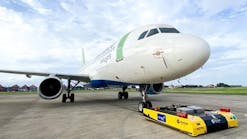Aviation Maintenance Returning to Growth in Face of Constraints
The Aeronautical Repair Station Association released its updated Global Fleet & MRO Market Report during its 2023 Annual Conference on March 15. The report, which is prepared by Oliver Wyman CAVOK, indicates that while constraints exist, the pandemic is no longer driving fleet growth or maintenance demand.
For both Oliver Wyman’s data and industry planning, this emergence from the business disruptions that began in 2020 allows for a return to more traditional modeling expectations. Aircraft and parts availability, supply chain volatility, and most pressingly workforce demands will determine how fully the global industry can recover and grow.
The report was briefed to ARSA’s attendees during the Legislative Day portion of its Conference, providing economic background to support later discussions with members of Congress and their staffs. Livia Hayes, Oliver Wyman CAVOK director, presented the findings to participants, illustrating the current and projected states of the North American and global aircraft fleets and related impacts on maintenance demand.
Hayes reported that the active fleet is almost back to pre-pandemic levels and in North America it is larger than in 2019. Passenger demand is expected to recover fully by 2024, with aircraft utilization rising steadily. These factors combined with several years of limited deliveries of new airframes – which kept average fleet ages high despite retirements of older aircraft – will drive maintenance demand for the decade: The market is expected to grow by a rate just shy of three percent through the 2030s.
Turning her focus to workforce, which received considerable discussion throughout ARSA’s Conference, Hayes noted that more than 300,000 Americans work in aviation maintenance and production, with 56 percent working at repair stations. These individuals combine to produce almost $63 billion in annual revenue for American firms as part of a global industry approaching $100 billion.
Hayes noted the top states for maintenance employment remain consistent year over year, with 42 percent of the total aviation maintenance workforce living in Florida, California, Texas, Georgia, and Ohio. In subsequent discussion, ARSA Executive Vice President Christian Klein noted that while big states always top lists of employment and investment, there are others, like Oklahoma, where aviation maintenance employment per-capita actually leads the nation even though its total employment falls outside the top five.
While ARSA members are already reporting considerable issues related to technician employment, the Oliver Wyman data indicate workforce challenges will continue. Even in its most optimistic scenario, the report indicates technician demand is likely to outstrip supply until the second half of the decade. The baseline projection – and certainly the pessimistic one – fails to return supply of available personnel back to balance with demand at any point within the forecast period.
“If the industry does grow the way we’re projecting it,” Hayes said, noting that Oliver Wyman’s projections usually are within one percent of actual numbers, “We’re going to have a big problem here in a few years in a gap in [workforce] demand [and supply].”
Oliver Wyman’s suggestions for business and policy improvements to stem career development problems mirror those promoted by ARSA and also reflect the work of government-convened bodies focused on engaging youth and women in aviation careers. In response to a question, Hayes noted that compensation for maintenance employment was competitive and she counsels employers to consider “total compensation,” including lifestyle benefits, in making careers enticing to potential employees.
ARSA members may view Hayes’ presentation in the March edition of the hotline member newsletter. For more information about the report and its related resources, as well as other analyses performed by and for ARSA, visit arsa.org/news-media/economic-data.



